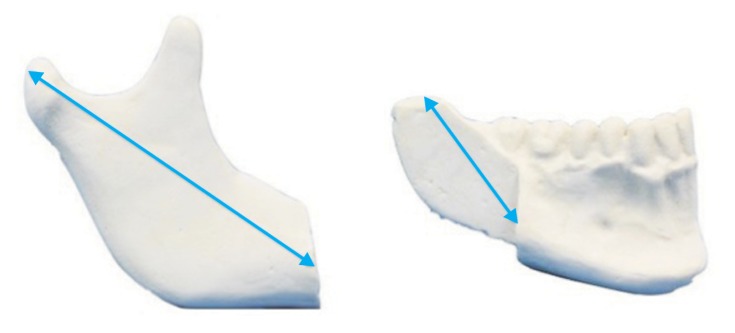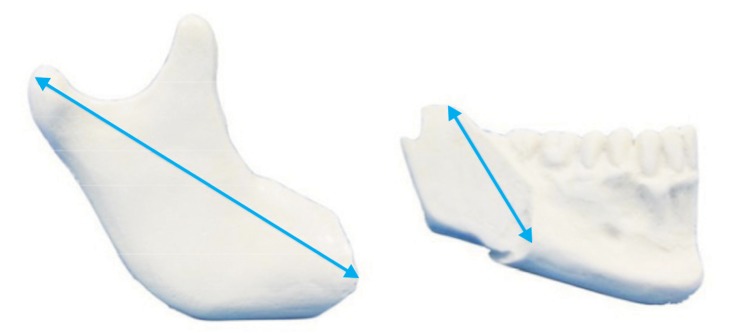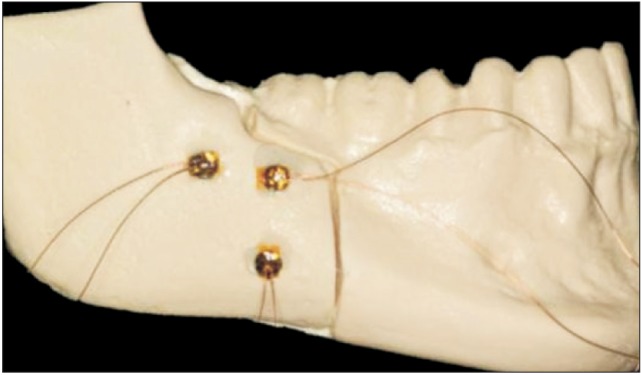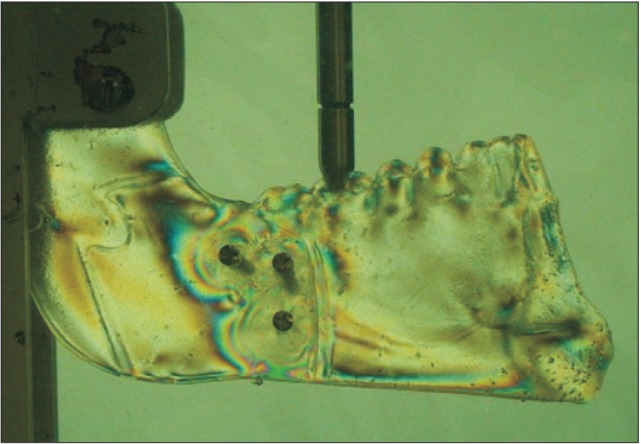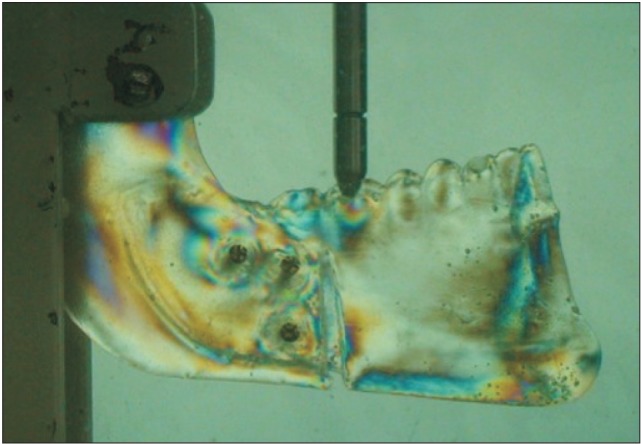J Korean Assoc Oral Maxillofac Surg.
2015 Jun;41(3):133-138. 10.5125/jkaoms.2015.41.3.133.
An in vitro comparison between two different designs of sagittal split ramus osteotomy
- Affiliations
-
- 1Department of Oral and Maxillofacial Surgery, State University of Campinas, Sao Paulo, Brazil.
- 2Department of Oral Rehabilitation and Periodontics, State University of Campinas, Sao Paulo, Brazil.
- 3Department of Oral and Maxillofacial Surgery, Universidad de La Frontera, Temuco, Chile. sergio.olate@ufrontera.cl
- 4Center for Biomedical Research, Universidad Autonoma de Chile, Temuco, Chile.
- KMID: 1797843
- DOI: http://doi.org/10.5125/jkaoms.2015.41.3.133
Abstract
OBJECTIVES
To evaluate the influence of the type of osteotomy in the inferior aspect of the mandible on the mechanical performance.
MATERIALS AND METHODS
The study was performed on 20 polyurethane hemimandibles. A sagittal split ramus osteotomy (SSRO) was designed in 10 hemimandibles (group 1) with a vertical osteotomy in the buccal side (second molar level) and final osteotomy was performed horizontally on the lingual aspect, while the mandible body osteotomy was finalized as a straight osteotomy in the basilar area, perpendicular to the body. For group 2, the same osteotomy technique was used, but an oblique osteotomy was done in the basilar aspect of the mandibular body, forming continuity with the sagittal cut in the basilar area. Using a surgical guide, osteosynthesis was performed with bicortical screws using an inverted L scheme. In both groups vertical compression tests were performed with a linear load of 1 mm/min on the central fossa of the first molar and tests were done with models made from photoelastic resin. Data were analyzed using Student's t-test, establishing a statistical significance when P <0.05.
RESULTS
A statistical difference was not observed in the maximum displacements obtained in the two osteotomies (P <0.05). In the extensiometric analysis, statistically significant differences were identified only in the middle screw of the fixation. The photoelastic resin models showed force dissipation towards the inferior aspect of the mandible in both SSRO models.
CONCLUSION
We found that osteotomy of the inferior aspect did not influence the mechanical performance for osteosynthesis with an inverted L system.
MeSH Terms
Figure
Reference
-
1. Obwegeser HL. Orthognathic surgery and a tale of how three procedures came to be: a letter to the next generations of surgeons. Clin Plast Surg. 2007; 34:331–355. PMID: 17692696.
Article2. Trauner R, Obwegeser H. The surgical correction of mandibular prognathism and retrognathia with consideration of genioplasty. I. Surgical procedures to correct mandibular prognathism and reshaping of the chin. Oral Surg Oral Med Oral Pathol. 1957; 10:677–689. PMID: 13441284.3. Dal Pont G. Retromolar osteotomy for the correction of prognathism. J Oral Surg Anesth Hosp Dent Serv. 1961; 19:42–47. PMID: 13719390.4. Epker BN. Modifications in the sagittal osteotomy of the mandible. J Oral Surg. 1977; 35:157–159. PMID: 264514.5. Ellis E 3rd. A method to passively align the sagittal ramus osteotomy segments. J Oral Maxillofac Surg. 2007; 65:2125–2130. PMID: 17884553.
Article6. Wolford LM, Davis WM Jr. The mandibular inferior border split: a modification in the sagittal split osteotomy. J Oral Maxillofac Surg. 1990; 48:92–94. PMID: 2294218.
Article7. Brasileiro BF, Grempel RG, Ambrosano GM, Passeri LA. An in vitro evaluation of rigid internal fixation techniques for sagittal split ramus osteotomies: advancement surgery. J Oral Maxillofac Surg. 2009; 67:809–817. PMID: 19304039.
Article8. Sato FR, Asprino L, Consani S, Noritomi PY, de Moraes M. A comparative evaluation of the hybrid technique for fixation of the sagittal split ramus osteotomy in mandibular advancement by mechanical, photoelastic, and finite element analysis. Oral Surg Oral Med Oral Pathol Oral Radiol. 2012; 114(5 Suppl):S60–S68. PMID: 23083958.
Article9. Sato FR, Asprino L, Noritomi PY, da Silva JV, de Moraes M. Comparison of five different fixation techniques of sagittal split ramus osteotomy using three-dimensional finite elements analysis. Int J Oral Maxillofac Surg. 2012; 41:934–941. PMID: 22510341.
Article10. Wyatt WM. Sagittal ramus split osteotomy: literature review and suggested modification of technique. Br J Oral Maxillofac Surg. 1997; 35:137–141. PMID: 9146874.
Article11. Vinicius de Oliveira M, de Moraes PH, Olate S, Alonso MB, Watanabe PC, Haiter-Neto F, et al. Morphometric study of mandibular ramus related to sagittal ramus split osteotomy and osteosynthesis. J Craniofac Surg. 2012; 23:1484–1487. PMID: 22976641.
Article12. Gallia L. Modification of the sagittal ramus osteotomy to produce a more accurate inferior border split. J Oral Maxillofac Surg. 1992; 50:1136–1137. PMID: 1527673.
Article13. Ochs MW. Bicortical screw stabilization of sagittal split osteotomies. J Oral Maxillofac Surg. 2003; 61:1477–1484. PMID: 14663815.
Article14. Haug RH, Serafin BL. Mandibular angle fractures: a clinical and biomechanical comparison--the works of Ellis and Haug. Craniomaxillofac Trauma Reconstr. 2008; 1:31–38. PMID: 22110787.
Article15. Chuong CJ, Borotikar B, Schwartz-Dabney C, Sinn DP. Mechanical characteristics of the mandible after bilateral sagittal split ramus osteotomy: comparing 2 different fixation techniques. J Oral Maxillofac Surg. 2005; 63:68–76. PMID: 15635560.
Article16. Kim HC, Essaki S, Kameyama T, Yamamoto K. Photoelastic analysis of internal screw fixation after sagittal split ramus osteotomy. J Craniomaxillofac Surg. 1993; 21:266–270. PMID: 8227377.
Article17. Grellmann W, Berghaus A, Haberland EJ, Jamali Y, Holweg K, Reincke K, et al. Determination of strength and deformation behavior of human cartilage for the definition of significant parameters. J Biomed Mater Res A. 2006; 78:168–174. PMID: 16628548.
Article18. Anucul B, Waite PD, Lemons JE. In vitro strength analysis of sagittal split osteotomy fixation: noncompression monocortical plates versus bicortical position screws. J Oral Maxillofac Surg. 1992; 50:1295–1299. PMID: 1447609.
Article19. Hammer B, Ettlin D, Rahn B, Prein J. Stabilization of the short sagittal split osteotomy: in vitro testing of different plate and screw configurations. J Craniomaxillofac Surg. 1995; 23:321–324. PMID: 8530709.
Article20. Peterson GP, Haug RH, Van Sickels J. A biomechanical evaluation of bilateral sagittal ramus osteotomy fixation techniques. J Oral Maxillofac Surg. 2005; 63:1317–1324. PMID: 16122596.
Article21. Borstlap WA, Stoelinga PJ, Hoppenreijs TJ, van't Hof MA. Stabilisation of sagittal split advancement osteotomies with miniplates: a prospective, multicentre study with two-year follow-up. Part I. Clinical parameters. Int J Oral Maxillofac Surg. 2004; 33:433–441. PMID: 15183405.22. Sato FR, Asprino L, Fernandes Moreira RW, de Moraes M. Comparison of postoperative stability of three rigid internal fixation techniques after sagittal split ramus osteotomy for mandibular advancement. J Craniomaxillofac Surg. 2014; 42:e224–e229. PMID: 24103461.
Article23. Champy M, Lodde JP. Mandibular synthesis. Placement of the synthesis as a function of mandibular stress. Rev Stomatol Chir Maxillofac. 1976; 77:971–976. PMID: 1071237.
- Full Text Links
- Actions
-
Cited
- CITED
-
- Close
- Share
- Similar articles
-
- Treatment of osteomyelitis in the rear area of the lingula of the mandible using sagittal split ramus osteotomy: a case report
- A case report of hemifacial microsomia
- Facial palsy after sagittal split ramus osteotomies: Case report
- A computerized tomographic study on the structure of the mandibular ramus
- Skeletal relapse pattern after sagittal split ramus osteotomy of mandibular prognathic patient

